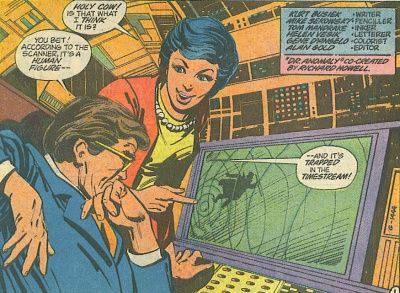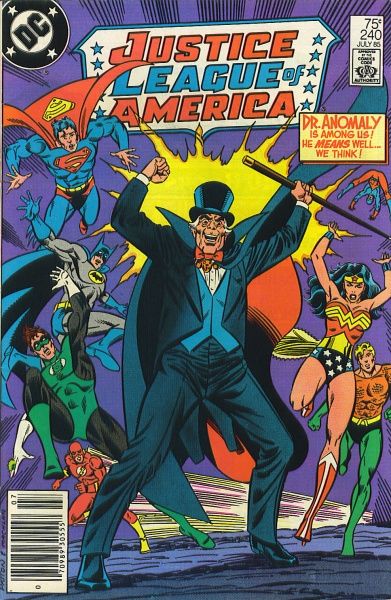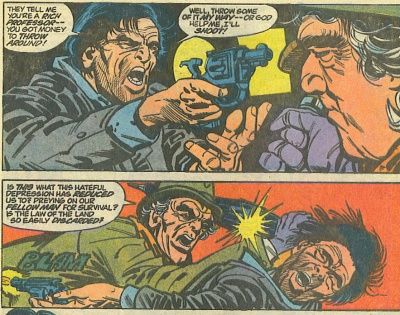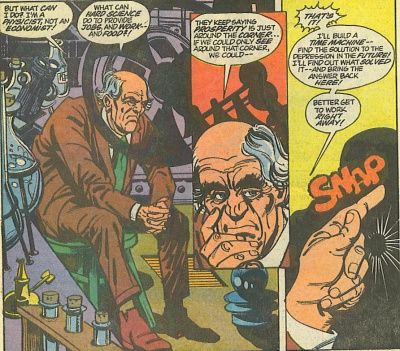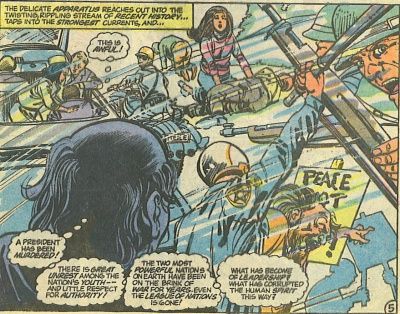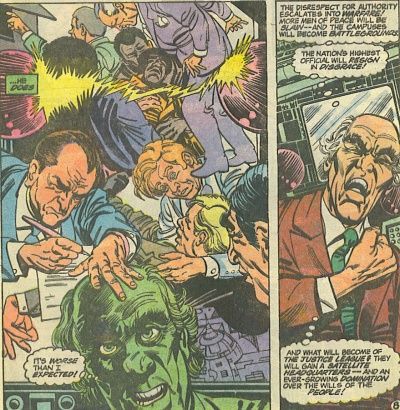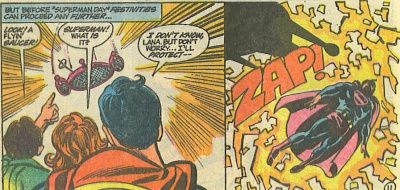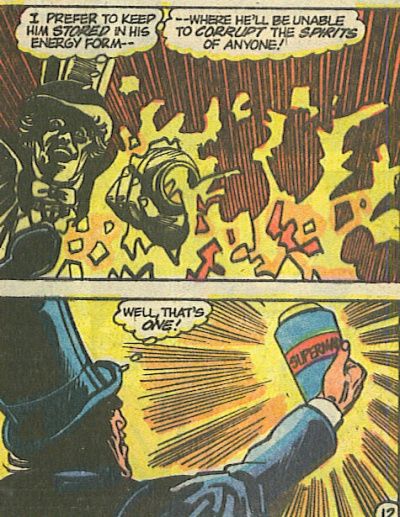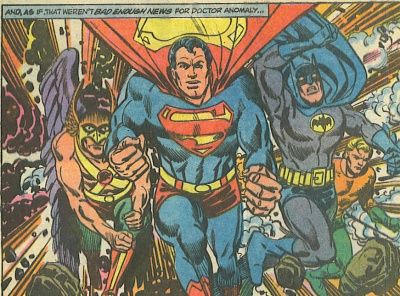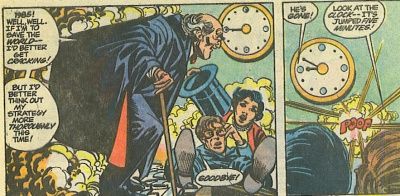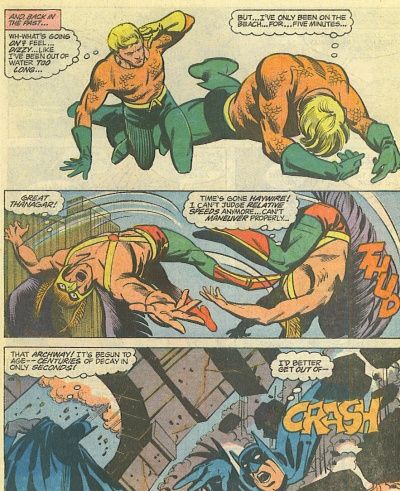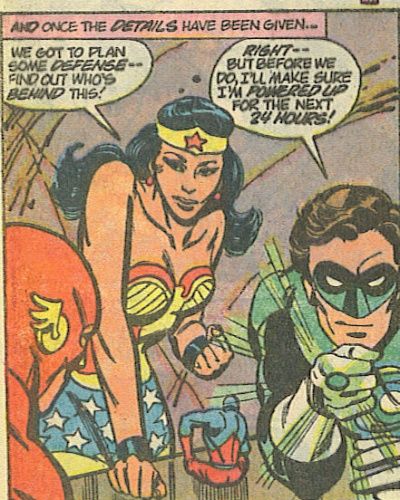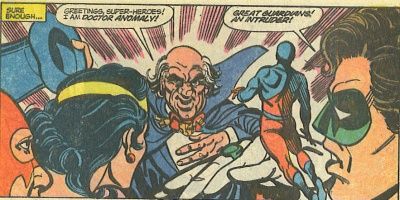The rules. Yes, I link to them every week. But you never who's new!
This week the randomness of the exercise brings us the second straight Kurt Busiek comic book. But I very much doubt if you will guess which one it is ...
Justice League of America #240 ("The Future Ain't What it Used to Be!") by Kurt Busiek, Mike Sekowsky, and Tom Mandrake. Published by DC, July 1985.
Man, Dr. Anomaly is way cool.
You'll notice that the "classic" JLA is on this cover, even though this was the era of the Detroit League (I assume; I'm not well-versed in JLA history, but the letter column is all about Gypsy and Vibe and Steel, so that's that). The letters column also helpfully points out that this is a fill-in issue that Busiek wrote over a year earlier, and for some reason decided to print now. Alan Gold, the editor and grand poobah of the letter column, doesn't explain why they chose to publish the story at that point, but the nice thing about is that it's a single-issue story, so a first-time comic book reader would have no trouble jumping right in. However, it's a time travel story, and time travel stories always make my head hurt and require huge amounts of disbelief suspension. So let's check it out!
We begin "precisely at 9 a.m." at the S.T.A.R. labs in Metropolis. I'm going to assume that a first-time comic book reader would be familiar with Metropolis, and although we don't find out what "S.T.A.R." means (I still don't know), we get that it's some kind of weird comic-book lab with a "temporal research division," which we find out in the second panel. Fred and Daphne, two S.T.A.R. lab technicians, are speaking, and Fred points out to Daphne that he's picked something up on the "chronal scanner." In the third panel, we see what they're seeing - a human figure "trapped in the timestream!" We also learn quickly that Daphne is Fred's boss, and that they're somehow romantically involved (all this, mind you, in four panels). Daphne asks Fred to learn more, and Fred, using magical comic-book science, "latch(es) onto our mystery wayfarer's personal timeline," and finds out how he got there. Man, comic book science is so awesome!
Fred skims over the man's timeline and discovers he's from 1932, "the most desperate winter of the Depression." His name is Dr. Phineas Quayle, born to a wealthy family in 1881, one of America's foremost physicists, and a personal friend of Herbert Hoover. He's also a compassionate rich guy, and when he finds a man with a gun in his house, he manages to get the gun away but ends up feeding the guy and giving him money. He frets about the Depression, and muses that "they keep saying prosperity is just around the corner ... if we could only see around that corner, we could ..." Because this is a comic book, he comes to the conclusion that if he builds a time machine, he can go into the future, find out how the Depression ends, come back to 1932, and put the answers to work! Considering that World War II brought us out of the Depression, I wonder if Dr. Quayle would have helped put Hitler in power a few months earlier than he actually was put in power and then egged him on to invade Czechoslovakia and France in 1933. Probably not.
The excellent thing about comic books is that Dr.Quayle snaps his fingers, says,"Better get to work right away!" and Fred and Daphne, watching this on their monitor, simply skip ahead a few months - yes, just a few months - as he's finishing his timemachine. Daphne says"I wonderif he'll succeed in his plans -build a timemachine?" and Fred says, "Listen to the Nobel Prizewinner! Of course he will - he ended up in the timestream, right?"Fred should have said, "Oh, you stupid woman - why don't you go back to the kitchen and make me a sammich? The men are busy inventing things!" Plus, Daphne is his boss. I guess Fred doesn't value his job or his family jewels all that much (although, to be honest, that is pretty stupid of Daphne). But again, I just love how in 1932, a man simply cobbles together a time machine (a "telechron apparatus," he calls it)in a matter of months. That's because he lived in the 1930s, when men were men and got things done! Except, you know, solved the economic problems. He hops in the time machine and fast-forwards decades, ending up in"a remote section of the Adirondacks," wherehis secluded lab would still be undisturbed. Dr. Quayle doesn't know much about the virus-like spread of subdivisions! He probably would have ended up in a ranch house's living room if he had really built atime machine! He casually turns on his "space/time viewer," which allows him to see what the world is like in, apparently, theearly 1970s. He sees JFK's assassination, VietnamWar protestors, and the killings at Kent State.He is shocked to learn that "the two most powerful nations onEarth have been on the brink of war for years. Even the League of Nations is gone!" Yeah, becauseit did such a good job back in his day to prevent wars. He thinks, "What has become of leadership? What has corrupted the human spirit this way?"
Well, the answer is ... superheroes! Yes, Dr. Quayle realizes that the world has been "inundated" with "gaudy" superheroes, who draw attention to themselves and overshadow the "noble efforts" of the United Nations. They're "insolent, arrogant, and non-cooperative," and they have "leached [sic] respect away from strong leadership, championing chaotic individualism." Yeah,who do those superheroes think they are - Americans? If they were good Commies, everything would be fine! He watches the foremost group, the "Justice League,"fight the Royal Flush Gang, and decides he needs to goback in time and turn his energies to "making sure this future never comes about!" But alas! his telechron only functions in one direction, so he's trapped in the awful future. Didn't he read Welles' The Time Machine? Of course it only works in one direction! Dr.Quayle, however, realizes that the people in the future have madeincredible leaps in technology, so he just can fix his timemachine using parts from his present. However, as Fred and Daphne skip ahead again, Dr. Quayle realizes he can't fix his machine, even though he's "created a virtual arsenal of devices that cause temporal anomalies." So he's stuck in the future, but he decides he's going to savehumanity ... from itself!!!! One of his new devices allows him to look a bit into the future, to see what's in store for the world. I'm not exactly sure what he sees beyond Nixon resigning, but it's more craptitude. It dismays him, especially because he sees that the Justice League "will gain a satellite headquarters - and an ever-growing domination over the wills of the people!" Who is this guy, Lex Luthor? He thinks, "Moral values on the wane ... little tin gods on therise ... the pernicious influence of these costumed corrupters must be stopped! And as the only right-thinking American left in this era ... it's my patriotic duty to stop it!" He decides that since the people respond to the "flash and glamor" of superpowers, he'll use his"time-bending devices" and become"Dr. Anomaly - the scourge of the superheroes ... and future savior of the world!" Phew!
I should probably speed it up, because that brings us to page 9. Yes, all that and we're not even halfway through the book yet. Today, that would be five of the six issues of a mini-series, and it would take a year for those issues to come out! Dr. Anomaly takes weeks to study his foes, and he realizes that he must stop Superman first. He has the perfect weapon because it hasn't been invented yet! Oh, that dastardly Dr. Anomaly! A few days later, as Superman is honored at "Superman Day," a strange craft flies up and blasts him, apparently reducing him to ashes. But no! Dr. Anomaly, on a building above the proceedings, think in exposition that he's only been "converted to pure energy," and he stores him in ... a Thermosâ„¢. I kid you not! He thinks to himself that "the teleporter the Justice League will build in the future, along with their satellite headquarters" could reconstitute Superman, which is a weird thing to think. But we'll leave it alone for now.
Fred and Daphne are still watching in the present, and Fred points out that he couldn't have taken out Superman, because he's still around in the present. Busiek decides to throw in some inter-office romance chatter, as Daphne says that Fred's discovery is so important, he might get promoted, but Fred's only interested in rekindling his affair with Daphne. If he gets promoted, he might get transferred, and then it's all over. They decide to return to the viewer rather than discuss it. I like how Daphne even acknowledges that Fred's discovery is important, but in the jaded scientific world of DC, he doesn't even care. "Oh, yeah, by the way, on my lunch break I discovered a way to see into the past and track people. But Daphne, I love you so much!"
Back in the past, Dr. Anomaly quickly takes care of Aquaman (which, let's face it, is awfully easy), Hawkman (ditto), and Batman. He keeps them trapped instead of killing them, because he wants to find a way to "strip them of their super-abilities." I guess you're going to lobotomize Batman, Dr. Anomaly, because he ain't got none! Back at JLA headquarters (I'm sure people have mentioned the oddness of JLA HQ being located in freakin' Rhode Island, but I'll bring it up here - freakin' Rhode Island????), the Flash and Green Lantern are discussing Flash's decision to tell his wife (girlfriend?) that he's the Flash when Wonder Woman and the Atomshow up ranting about four Justice Leaguers disappearing. Good observational skills, Flash and Green Lantern! Green Lantern powers up his ring, which Dr. Anomaly observes and catalogs, and then he appears to the four heroes and introduces himself. Flash and GL rush him, but he's not really there! He tells them he's responsible for the disappearance of their teammates, and he challenges them to win them back. He tells them where he is, and when they arrive, he uses a device to increase his reaction time, so he's able to punch out Flash. He then somehow moves Green Lantern ahead 24 hours, so his ring is no longer charged. This causes him to collapse, although I'm not sure why. I mean, he'd no longer be superpowered, and he'd be tired, but would he collapse? I've stayed up for longer than 24 hours before (okay, once), and you get to that weird place where you're running on pure adrenaline and you're beyond tired. Suck it up, Hal! Meanwhile, inside Dr. Anomaly's laboratory, the Superman Thermosâ„¢ is starting to rock back and forth. What could this portend? Wonder Woman is punching Dr. Anomaly, but he can perceive them at a fraction of the speed at which they're delivered, so he can easily avoid their full impact. Atom, meanwhile, tries to sneak up on the good doctor, but Dr. Anomaly manages to slow his speed down so that it will take him hours to move a few inches. Dr. Anomaly changes Wonder Woman's perceptions so that she's much slower, and defeats her. We keep cutting back to Superman, who finally rocks his Thermosâ„¢ off the ledge and cracks it on the ground. As Dr. Anomaly gloats outside, his lab explodes! (He actually says "Jumping Jehoshaphat!" He's from the 1930s, remember, and that's what they said back in the Depression - incorrect spelling and all!) The Leaguers all snap out of whatever Dr. Anomaly did to them, and as they leap up to fight Dr. Anomaly, the other four Leaguers bust out of the lab in dramatic fashion (except for Batman, who looks like he caught some shrapnel in the butt):
We never do learn how they changed back from pure energy. Oh well - it's a comic book! Dr. Anomaly is surrounded, but he thinks to himself that there's only one way out: he disappears in a puff of smoke! Fred, who's still watching, suggests that he projected himself into the future (without his time machine?) without following a specific path, so that Superman and Flash couldn't track him, and that's how he got stuck in the timestream. Suddenly the chronal scanner explodes, and when the smoke clears, Dr. Anomaly is standing there! He asks what year it is, and Fred tells him it's 1985. Dr. Anomaly says he better get going because he still has to save the world, and he disappears again, as the clocks jump ahead five minutes. Daphne says they need to call the police or the JLA, and once that's done, they leave for the night. It's 9 p.m. (we started at 9 a.m., remember, and I have no idea why the twelve hours is significant), and Fred asks Daphne if she wants to go to dinner. He says they havea lot to talk about, like ... the future! And with that, the issue ends. We don't even get to find out if they drive to dinner in the Mystery Machine van!
Man, this issue is packed. We have to assume that a first-time comic book reader would at least be familiar with the big guns of the DCU, so even though Busiek doesn't really introduce our heroes properly, we figure it out quickly enough. I mean, it's Superman, for crying out loud! Busiek does a decent job showing us a few of the specific things associated with our heroes - Aquaman can't be out of salt water for too long, Green Lantern needs to recharge his ring - and then just moves on. It's Dr. Anomaly's story, after all, and Busiek does fine with him.
It's a perfect silly comic book, actually, because a first-time comic book reader is forced to suspend a TON of disbelief when it comes to the science of the issue. If you have never read a comic book and this just seems too stupid to imagine, you're probably better off not reading many superhero books. If you can put aside any objections to the science in the story, then you'll be fine. It's a good introduction to the kind of things you can expect in a superhero comic, and therefore it's a good place to start, because it tells a complete story and shows you what the genre is like. You can make a decision based solely on this issue. Sekowsky's art does a good job making all of Busiek's wild ideas seem plausible, too. In a few panels, his characters look a bit cramped, but generally, he does a good job both with the non-action and action panels (even though the gun in the burglar's hand in Dr. Quayle's house switches from the right to the left in successive panels, rather mysteriously). Sekowsky's Wonder Woman, in particular, is fantastic. She looks foreign and exotic, which considering the fact that she's sort of Greek, is very nice to see.
Overall, this comic does what it should: tells a decent superhero story with an intriguing villain who has a solid motivation, and it helps get a new reader into the idea of superheroes and what they're all about. A new reader might be a bit disappointed to come back the following week and see losers like Vibe and Steel, but the point is to get them to come back, and this issue does a fine job with that. It's interesting to see how Busiek, so early in his career, was already using the Silver Age as a template, because this story has Silver Age written all over it. I guess it's been good for him, so why not milk it? This comic reminds us all of the goofy charm that comics have, and although it's not something I want to see all the time (because I have no particular love for the Silver Age), it's a fine way to introduce someone to comics.
By the way, whatever happened to Dr. Anomaly? There seems to be at least one other good story in him.
Next time: well, next weekend I'll be out of town (in fashionable Tucson, AZ!), so it won't be until two weeks from now, but I have to get a non-Busiek comic, don't I?

